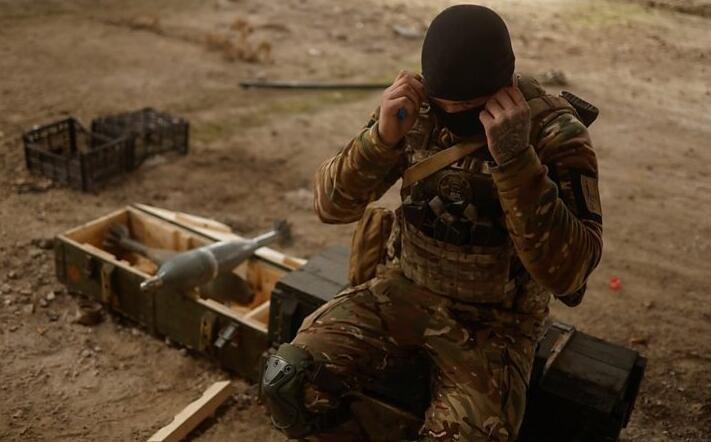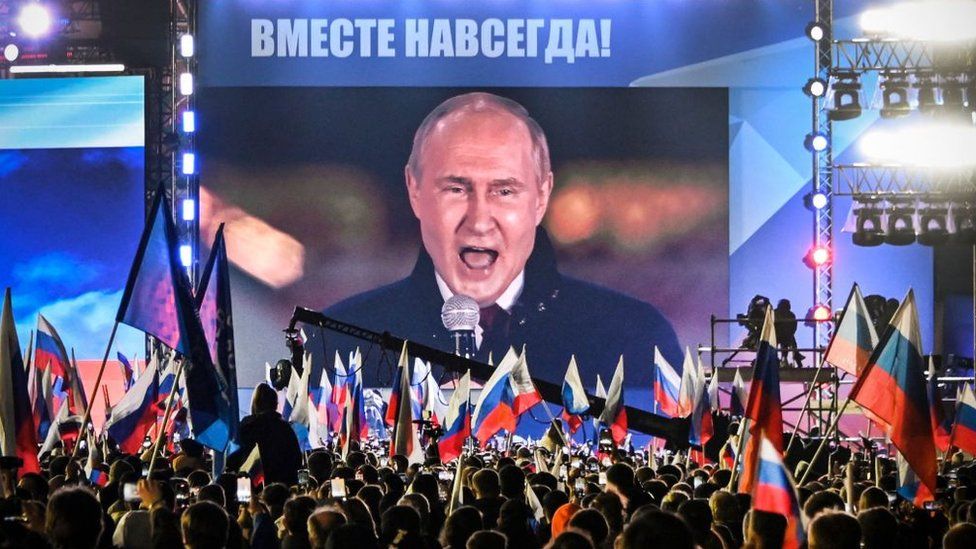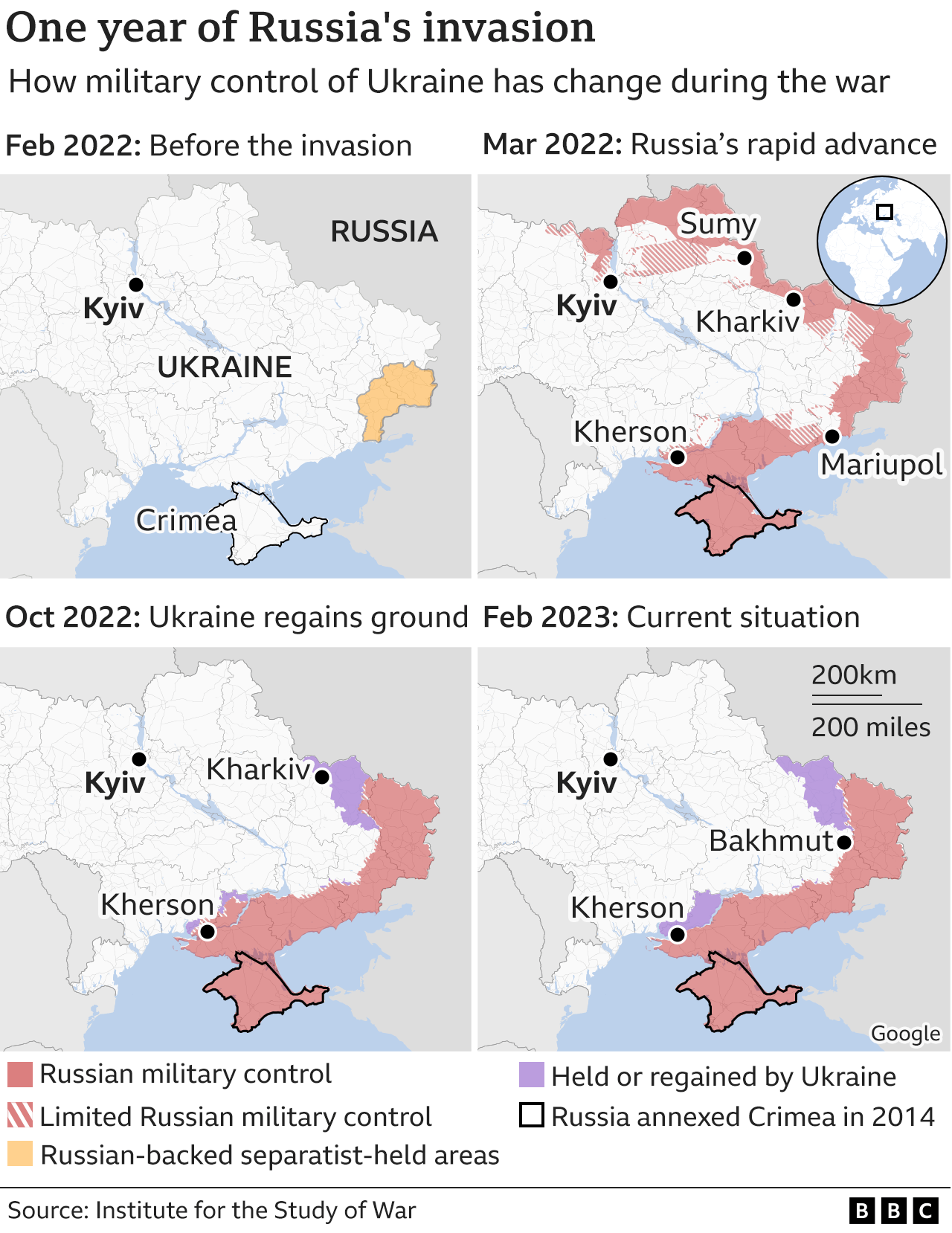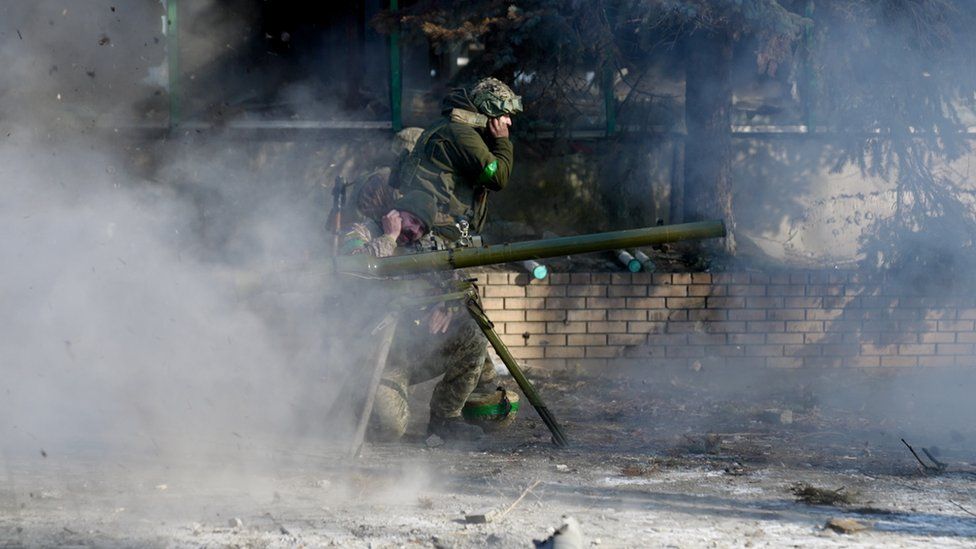
Has Putin’s war failed and what does Russia want?
When Vladimir Putin sent up to 200,000 soldiers into Ukraine on 24 February 2022, he wrongly assumed he could sweep into the capital, Kyiv, in a matter of days and depose the government.
After a series of humiliating retreats, his initial invasion plan has clearly failed, but Russia’s war is not yet lost.
What was Putin’s original goal?
Even now, Russia’s leader describes the biggest European invasion since the end of World War Two as a “special military operation”. Not the full-scale war that has bombed civilians across Ukraine and left more than 13 million either as refugees abroad or displaced inside their own country.
His declared goal on 24 February 2022 was to “demilitarise and denazify” Ukraine and not occupy it by force, days after backing independence for eastern Ukrainian territories occupied by Russian proxy forces since 2014.
He vowed to protect people from eight years of Ukrainian bullying and genocide – a Russian propaganda claim with no foundation in reality. He spoke of preventing Nato from gaining a foothold in Ukraine, then added another objective of ensuring Ukraine’s neutral status.
President Putin never said it out loud, but high on the agenda was toppling the government of Ukraine’s elected president. “The enemy has designated me as target number one; my family is target number two,” said Volodymyr Zelensky. Russian troops made two attempts to storm the presidential compound, according to his adviser.
Russian claims of Ukrainian Nazis committing genocide never added up, but Russian state-run news agency Ria Novosti explained that “denazification is inevitably also de-Ukrainisation” – in effect, erasing the modern state of Ukraine.
For years, the Russian president has denied Ukraine its own statehood, writing in a lengthy 2021 essay that “Russians and Ukrainians were one people” dating back to the late 9th Century.
How Putin changed his war aims
A month into the invasion and his campaign goals were dramatically scaled back after a retreat from Kyiv and Chernihiv. The main goal became the “liberation of Donbas” – broadly referring to Ukraine’s two industrial regions in the east of Luhansk and Donetsk.
Forced into further retreats from Kharkiv in the north-east and Kherson in the south, Russia’s aims remain unchanged, but it has shown little success in achieving them.
Those reverses on the battlefield rushed Russia’s leader into annexing four Ukrainian provinces last September, without having full control of any of them: neither Luhansk or Donetsk in the east, nor Kherson or Zaporizhzhia to the south.

President Putin was forced into Russia’s first mobilisation since World War Two, although it was partial and limited to some 300,000 reservists.
A war of attrition is now taking place along an active front line of 850km (530 miles) and Russian victories are small and rare. What was meant to be a quick operation is now a protracted war that Western leaders are determined Ukraine should win. Any realistic prospect of neutrality for Ukraine is long gone.
President Putin warned in December that the war “could be a lengthy process”, but then added later that Russia’s goal was “not to spin the flywheel of military conflict”, but to end it.
What has he achieved?
The biggest success President Putin can lay claim to is establishing a land bridge from Russia’s border to Crimea, annexed illegally in 2014, so it is no longer reliant on its bridge over the Kerch Strait.
He has spoken of the capture of this territory, which includes the cities of Mariupol and Melitopol, as a “significant result for Russia”. The Sea of Azov, inside the Kerch Strait, “has become Russia’s internal sea”, he declared, pointing out that even Russian Tsar Peter the Great did not manage that.


Has he failed?
Beyond seizing a territorial corridor to Crimea, Russia’s bloody, unprovoked war has been a disaster for itself and the country it was unleashed on. So far, it has achieved little more than exposing the brutality and inadequacy of the Russian military.
While cities such as Mariupol were flattened, details of war crimes have emerged against civilians in Bucha, near Kyiv, and have led to an independent report that accused Russia itself of state-orchestrated incitement to genocide.
But it is the military failures that have shown Russia at its weakest:
- The retreat of 30,000 Russian troops across the Dnipro river from Kherson in November was a strategic failure
- A 64km (40-mile) armoured convoy that ground to a halt near Kyiv at the start of the war was a logistical failure
- The deaths of a large number of recently mobilised troops in a Ukrainian new-year missile attack on Makiivka were an intelligence failure
- The sinking of the flagship Black Sea battle cruiser the Moskva was a defensive failure, as was the spectacular attack in October 2022 that shut the Kerch Strait bridge for weeks.
Russia’s warnings to the West against arming Ukraine have gone unheeded, with assurances of Western support for “as long as it takes”.
Ukraine’s artillery was boosted by superior Himars missiles and the promise of German Leopard 2 tanks.
But this war is not over. The fight for Donbas continues. Russia has captured the town of Soledar this year and has hopes of seizing the eastern city of Bakhmut on the road to key cities to the west, and of recapturing territory it lost last autumn.

Putin watchers believe he will seek to extend control of the four regions that he has declared to be part of Russia, not just in Donbas, but towards the key city of Zaporizhzhia.
Should he need to, President Putin could extend mobilisation and drag out the war. Russia is a nuclear power and he has indicated he would be prepared, if necessary, to use nuclear weapons to protect Russia and cling on to occupied Ukrainian land. “We will certainly make use of all weapon systems available to us. This is not a bluff,” he warned.
Kyiv believes Russia is also seeking to depose the pro-European government in Moldova, where Russian troops are based in the breakaway region of Transnistria bordering Ukraine.
Has Putin been damaged?
President Putin, 70, has sought to distance himself from military failures, but his authority, at least outside Russia, has been shredded and he makes few trips beyond its borders.
At home, Russia’s economy on the surface appears to have weathered a series of Western sanctions, although its budget deficit has soared and oil and gas revenue has fallen dramatically.
Any attempt to gauge his popularity is fraught with difficulty.
Dissent in Russia is highly risky, with jail sentences handed out for anyone spreading “fake news” about the Russian military. Those opposing Russia’s leadership have either fled or, as with main opposition figure Alexei Navalny, been thrown into prison.
Ukraine’s shift to the West
The seeds of this war were sown in 2013, when Moscow persuaded Ukraine’s pro-Russian leader to scrap a planned pact with the European Union, prompting protests that ultimately brought him down and led to Russia seizing Crimea and staging a land-grab in the east.
Four months into Russia’s 2022 invasion, the EU granted Ukraine candidate status and Kyiv is pushing to be accepted as soon as it can.
Russia’s long-time leader was also desperate to prevent Ukraine from entering Nato’s orbit, but his attempt to blame the Western defensive alliance for the war is false.
Not only did Ukraine reportedly agree before the war a provisional deal with Russia to stay out of Nato, but in March, President Zelensky offered to maintain Ukraine as a non-aligned, non-nuclear state: “It’s a truth and it must be recognised.”
Was Nato to blame for the war?
Nato member states have increasingly sent Ukraine air defence systems to protect its cities, as well as missile systems, artillery and drones that helped turn the tide against Russia’s invasion.
But it is not to blame for the war. Nato’s expansion comes as a response to the Russian threat – Sweden and Finland only applied to join because of the invasion.


Blaming Nato’s expansion eastwards is a Russian narrative that has gained some ground in Europe. Before the war, President Putin demanded Nato turn the clock back to 1997 and remove its forces and military infrastructure from Central Europe, Eastern Europe and the Baltics.
In his eyes, the West promised back in 1990 that Nato would expand “not an inch to the east”, yet did so anyway. That was before the collapse of the Soviet Union, however, so the promise made to then Soviet President Mikhail Gorbachev referred merely to East Germany in the context of a reunified Germany.
Mr Gorbachev said later that “the topic of Nato expansion was never discussed” at the time.
Nato maintains it never intended to deploy combat troops on its eastern flank, until Russia annexed Crimea illegally in 2014.
Comments (0)